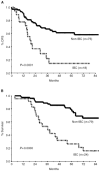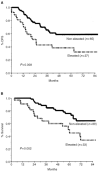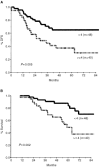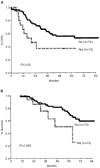Prediction of outcome in locally advanced breast cancer by post-chemotherapy nodal status and baseline serum tumour markers
- PMID: 12454769
- PMCID: PMC2376279
- DOI: 10.1038/sj.bjc.6600616
Prediction of outcome in locally advanced breast cancer by post-chemotherapy nodal status and baseline serum tumour markers
Abstract
In spite of the apparent improvement in outcome in locally advanced breast cancer, the prognosis remains dismal in many patients. The aim of this study was to define prognostic subgroups within this heterogeneous entity. Between 1990 and 1999, 104 consecutive patients with locally advanced breast cancer were treated by a multimodality programme consisting of 4-6 courses of CAF induction chemotherapy followed by surgery, breast-conserving when feasible. In most cases, chemotherapy was then resumed, up to a total of eight courses, followed by locoregional radiation therapy. Patients with hormone receptor-positive tumours received tamoxifen (20 mg day(-1)) for 5 years. At a median follow-up of 57 months, the 5-year overall survival for the entire group and the disease-free survival for the 94 operated patients were 65% and 53%, respectively. Univariate analysis identified 10 prognostic factors of overall and disease-free survival, of which four retained significance on multivariate analysis: inflammatory breast cancer (P=0.0000, P=0.0004, respectively), baseline tumour markers (P=0.003 for both), post-chemotherapy number of involved nodes (P=0.003; P=0.017) and extracapsular spread (P=0.052; P=0.014). In conclusion, besides inflammatory features, baseline tumour markers and post-chemotherapy nodal status are strong predictors of outcome in locally advanced breast cancer.
Copyright 2002 Cancer Research UK
Figures




Similar articles
-
Outcomes of locally advanced breast cancer patients with ≥ 10 positive axillary lymph nodes.Med Oncol. 2013;30(3):615. doi: 10.1007/s12032-013-0615-7. Epub 2013 Jun 1. Med Oncol. 2013. PMID: 23729267
-
Assessment of prognostic factors for locally advanced breast cancer.J Indian Med Assoc. 2012 May;110(5):284-6. J Indian Med Assoc. 2012. PMID: 23360018
-
Serum markers and prognosis in locally advanced breast cancer.Tumori. 2005 Nov-Dec;91(6):522-30. doi: 10.1177/030089160509100613. Tumori. 2005. PMID: 16457152
-
Locally advanced breast cancer.Curr Treat Options Oncol. 2000 Aug;1(3):228-38. doi: 10.1007/s11864-000-0034-9. Curr Treat Options Oncol. 2000. PMID: 12057165 Review.
-
Prediction of recurrence for advanced breast cancer. Traditional and contemporary pathologic and molecular markers.Surg Oncol Clin N Am. 1995 Oct;4(4):601-32. Surg Oncol Clin N Am. 1995. PMID: 8535901 Review.
Cited by
-
Outcome of neoadjuvant chemotherapy in locally advanced breast cancer: A tertiary care centre experience.Indian J Med Paediatr Oncol. 2014 Jul;35(3):215-20. doi: 10.4103/0971-5851.142038. Indian J Med Paediatr Oncol. 2014. Retraction in: Indian J Med Paediatr Oncol. 2015 Jan-Mar;36(1):71. doi: 10.4103/0971-5851.151798. PMID: 25336793 Free PMC article. Retracted.
-
Locally Advanced Breast Cancer (LABC): Real-World Outcome of Patients From Cancer Institute, Chennai.JCO Glob Oncol. 2021 May;7:767-781. doi: 10.1200/GO.21.00001. JCO Glob Oncol. 2021. PMID: 34043414 Free PMC article.
-
Is extracapsular tumour spread a prognostic factor in patients with early breast cancer?Int J Clin Oncol. 2013 Aug;18(4):607-13. doi: 10.1007/s10147-012-0439-z. Epub 2012 Jul 5. Int J Clin Oncol. 2013. PMID: 22763660
-
Update on inflammatory breast cancer.Breast Cancer Res. 2005;7(2):52-8. doi: 10.1186/bcr997. Epub 2005 Jan 20. Breast Cancer Res. 2005. PMID: 15743511 Free PMC article. Review.
-
Aquaporin-3 Controls Breast Cancer Cell Migration by Regulating Hydrogen Peroxide Transport and Its Downstream Cell Signaling.Mol Cell Biol. 2016 Feb 1;36(7):1206-18. doi: 10.1128/MCB.00971-15. Mol Cell Biol. 2016. PMID: 26830227 Free PMC article.
References
-
- CheungKLGravesCRLRobertsonFJR2000Tumour marker measurements in the diagnosis and monitoring of breast cancer Cancer Treatment Rev 2691102 - PubMed
-
- CoxDR1972Regression models and life tables JR Stat Soc Ser B 34187220
-
- DeLenaMZucaliRViganottiGValagussaPBonadonnaG1978Combined chemotherapy-radiotherapy approach in locally advanced (T3b-T4) breast cancer Cancer Chemother 15359 - PubMed
-
- EORTC Breast Cancer Cooperative Group2000Clinical Research and Treatment in Breast Cancer Manual for Clinical Research and Treatment in Breast CancerProceedings of the 2nd European Breast Cancer Conference, 2000,Brussels, BelgiumSeptember 26–304th edition,pp107108
-
- FeinDAMendenhallNPMarshRDBlandKICopelandIIIEMMillionRR1994Results of multimodality therapy for inflammatory breast cancer: an analysis of clinical and treatment factors affecting outcome Am Surg 6022225 - PubMed
MeSH terms
Substances
LinkOut - more resources
Full Text Sources
Medical

